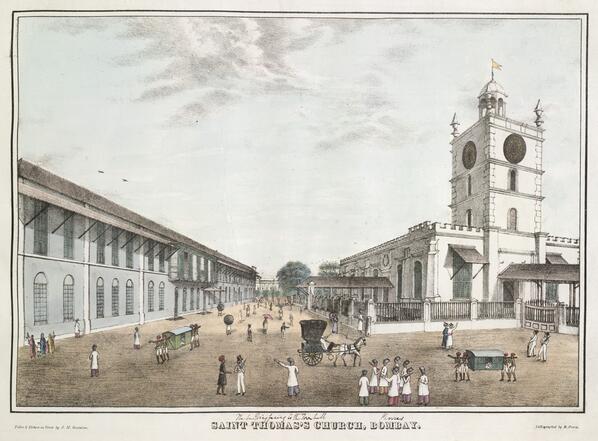There was a time when the Kala Ghoda statue was still at Kala Ghoda and the only traffic at Flora Fountain consisted of horse carriages.

Located in the Fort area of Mumbai, the fountain today is a hub of activity. Built in 1864, the fountain is a representation of Goddess of flowers-in 1960, ‘Flora Fountain’ was renamed Hutatma Chowk
It cost Rs 47,000 tobuild in the year 1864. Designed by R Norman Shaw and
sculpted in imported Portlandstone by James Forsythe,
the fountain was to be named afterGovernor Frère, but took on the name of the Roman goddess who formed apart of the fountain’s design
. flora fountain statue occupies the exact spot where the original church gate of bombay fort was -see below

inside view of Bombay fort with CHURCH GATE OF BOMBAY FORT in front and Times of india[BOMBAY TIMES] office second building from corner next to FAVRE LEUBA watch shop.A palanquin taxi and a bridled horse outside Times office(water had to be carried into the fort by bullock carts ,tell tale signs of that seen on the dirt road)
below photo of same square before the statue made
The name Kala Ghoda (काळा घोडा in Marathi), meaning black horse, came from the black stone statue of King Edward VII mounted on a horse which used to stand in Kala Ghoda Square
Four Kings: King Edward VII (right) with his successors—(from left to right) his son, the future King George V, and grandsons, the future King Edward VIII and King George VI.

later shifted to Rani Bagh,[‘Jijamata Udyan’ Garden] Byculla, Mumbai after India's independence
Below:-The Esplanade Mansion, India's oldest surviving cast iron building,[2] is in Kala Ghoda. Formerly known as Watson's Hotel, it was the site where films were introduced to India with a screening of the Lumiere Brothers Cinematograph in 1896. The offices of art publication, Marg, are on the third floor of the historic Army and Navy Building


Dedication ceremony of the gateway, 1924
before gate way was made it was just the arrival point for passengers from England after a long journey by ship , lasting many months-upto 6 months.see below the photos of its transformation from 1800's to 1924
Amphitheatre (Apollo Bunder)
The area that is known as Apollo Bunder was initially just a maze of docks and wharves till the British government
decided to reclaim the land in order to build a welcoming arch to rece ive King George V and Queen Mary during
their forthcoming visit. S V Rajadhakshya, the chief civil engineer during the British Raj, built Apollo Bunder in
1908. In those days, the British had started the practice of military bands entertaining the public at certain
locations around town, and the Bunder was one of the popular venues. An amphitheatre was constructed to
entertain the public. In its place today stands the Gateway of India


on Christmas Day, 1718 the Church was formally opened by order of the Governor, Charles Boone
.................................................................................................................................................................
ATTEND THE EXHIBITION
WHAT: From Mumbai to Bombay, an exhibition of 100-year-old pictures of the city
WHRE: Bajaj Bhavan, Nariman Point
CALL: 2204-4016
TAKE THEM HOME: The photos are priced at Rs 5000 each, which means time-travelling art lovers can even take home a souvenir.{ha ha ha
same will be available in chor bazar for 500]
same will be available in chor bazar for 500]
ENTRY TO THE EXHIBITION IS FREE